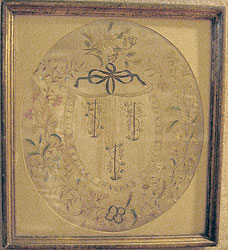| Join | Official Historian | City of Stamford | Blog | About Us | |
| Jewish Historical Society | Civil War Roundtable | Contact Us | |
|
|
|
|
The Stamford Historical Society PresentsPortrait of a Family: Stamford through the Legacy of the Davenports
Noah Welles 1718–1776“Civil government is absolutely necessary to public The Reverend Noah Welles, minister of the First Congregational Church, was born in Colchester, Connecticut. Upon graduating Yale College in 1741, he continued on as Dean’s Scholar for an additional year. After this he began teaching, studying theology and occasionally preaching to the tutored at Yale from 1745 to 1746. During this period, the pulpit of the church in Stamford became vacant with the death of the Reverend Ebenezer Wright. A committee of the church, seeking a replacement, presented its situation before the Fairfield West Association, which in June 1746 recommended Noah Welles. After serving an interval on trial basis at the Stamford Church, he became their pastor and was “ordained and installed there” on December 31, 1746. Although church and state were one at that time, immediately following his ordination and installation he began keeping a volume of church records separate from those of the town. A little over a year later he was able to procure, by subscription, a bell for the church. This was the first one to be used in calling worshipers to service in Stamford. In 1774 he became a Fellow of Yale College and received the degree of Doctor of Divinity from the College of New Jersey. He was married in 1751 to Abigail, daughter of the Reverend Benjamin Woolsey of Oyster Bay, New York. Of their thirteen children, the second daughter, Mary Sylvester Welles married the Hon. John Davenport of Stamford. Though he could be controversial, notably in a series of pamphlets defending the validity of Congregational ordination, he was able to convey his message with dignity, in a pleasant, intelligent, sometimes satirical manner. After Parliament passed the Stamp Act his sermons and writings clearly challenged Great Britain’s authority by promoting confrontation on such issues. This is reflected in Patriotism Described and Recommended an election sermon he delivered before the Connecticut General Assembly in 1764. As Connecticut and other colonies debated the issue of independence he made abundantly clear of his favoring such an undertaking. In 1776, thirty years to the day after Welles became pastor of the Stamford church, he died from “jail-fever” which he contracted while ministering to sick British prisoners during a term of duty as chaplain in the American Army. On display in the exhibit:“Patriotism described and recommended, in a sermon preached before the General Assembly of the colony of Connecticut, at Hartford, on the day of the anniversary election, May 10th, 1764.” “He was a pronounced advocate of resistance to British oppression, setting forth from the pulpit the righteousness and duty of it, both at the time when the Stamp Act was creating excitement and in the opening days of the Revolution.” Dictionary of American Biography [D. A. B.]. “True patriotism then, considered as a principle, is the same thing with public spirit, or a generous love to our country, a regard for the happiness of our fellow-creatures, especially a tender concern for the welfare of our fellow-subjects.” Noah Welles. Private Collection Manuscript sermons of the Reverend Noah Welles, Pastor of The First Congregational Church Sermon on top was originally delivered in 1757 and again on October 21, 1759 with additional text: on ye taking of Quebec. During the French and Indian War the British captured Quebec on September 18, 1759. A treaty ending hostilities was signed in 1763, resulting in France losing Canada and much of the American Midwest. Gift of Katharine Murphy
Silk embroidery on satin with three grapevines in center and floral border. Worked by Maria T. Holly, August 1800, daughter of John William Holly (1762-1838) and Rebecca Welles (1767-1859), both of Stamford. Maria was a descendant of John Holly, one of the founders of Connecticut and the maternal granddaughter of the Reverend Noah Welles. She married Henry Hudson of Hartford. Stamford Historical Society William and Mary Armchair According to the donor, this chair belonged to Noah Welles' wife, whose daughter Mary Sylvester Welles, married Major John Davenport. The Rev. Noah Welles had many chairs listed in the probate inventory of his estate. At some point, probably in the late l9th century, the feet were cut down and rockers put on. They were later removed but the scars remain. Gift of Mrs. Elizabeth Davenport Spence |
||
|
|
 Seal of the State of Connecticut
Seal of the State of Connecticut